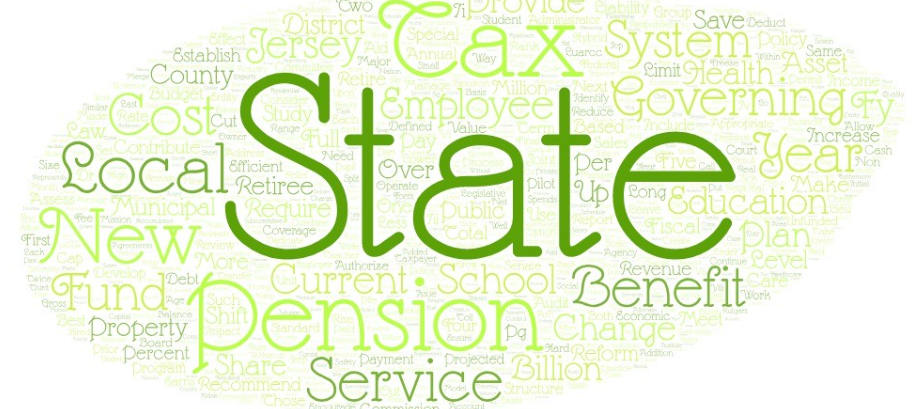So what about this? A Word Cloud Comparison of the Murphy and Sweeney Economic Plans

If Governor Phil Murphy and Senate President Steve Sweeney were to characterize their relationship on Facebook my guess is both would say “It’s Complicated”. Anyone who pays the slightest bit of attention knows that the two most powerful democrats in New Jersey don’t seem to like each other or get along all that well. Without a doubt, it is fun to chalk that up to their high school like personality differences. Steve Sweeney acts and looks like a high school football lineman and Phil Murphy is the student body president and captain of the cheer squad. Ironworker Sweeney builds things with his hands and Finance Guy Murphy builds things with his head. Both are part of the “cool” kids, just in different ways. We can also talk about the he said-he said arguments about who didn’t call who, who didn’t show up to a date, who talked behind the others back. But let’s not.
Sometimes these personality and dating differences can mask real differences in policy choices and approaches. Nowhere has this been more apparent than in the recent economic proposals of each man. Sweeney came out first in August with his “Path to Progress: Policies to Save New Jersey” (http://pathtoprogressnj.org/). Murphy followed earlier this week with his “State of Innovation: Building a Stronger and Fairer Economy in New Jersey” (https://www.njeda.com/pdfs/StrongerAndFairerNewJerseyEconomyReport.aspx).
My students and I did a class exercise where we read each report and then created a Word Cloud of them. For those of you that don’t know, a word cloud is a visual representation of the words in a document. The bigger the size of a word the more times it appears in the document. It is a fun exercise because you get to see a right in front of you what each document “talks” about the most. It is also important to recognize that different Word Cloud programs can lead to different results. Each program decides what to put in and what to leave out. The programs also have a tough time understanding numbers, to the algorithm 5 and five are not the same. We decided to basically leave everything in, but take out numbers at the end. It is also important after creating the Word Cloud to go back in and double check the examples to make sure you understand the context that specific words are used. We will see that in a minute but first here are the word cloud we came up with for the two economic plans.
See if you can guess which cloud goes to which plan.


If you guessed that the first one comes from Governor Murphy send in a self-addressed stamped envelope and we will give you a “good job” sticker. Alternatively, if someone wants to teach me how to do those damn Facebook/Instagram/Snap-Chat stickers let me know I will send you one electronically.
Word clouds are kind of like a Rorschach test. You can see and focus on different things and interpret the results in different ways. Here are some of the things that jumped out at us.
What is the State?
What jumps out immediately is that both seem to really want a “NEW STATE” since both words are quite prominent. Just kidding, well sort of.
While they both use the word “STATE” a lot, they use it in different ways. That provides an interesting glimpse into each man. In the Murphy Report, the word is most often used in the phrase “OUR STATE” or in as a tool for comparing New Jersey to “OTHER/PEER” STATES”. Murphy uses it to talk about the “people” of New Jersey but also the “government” of other places. In the Sweeney document, the word is most often framed as “THE STATE” or to a STATE (fill in the blank program or law). For Sweeney, the term is directly linked to the actions of the government of New Jersey.
Innovating & Investing vs. Pension & Taxes; Government & Governing
The Murphy plan uses some variation of the word INNOVATION 98 times. The Sweeney plan doesn’t use it at all. The Murphy plan uses some version of INVESTING 94 times, Sweeney uses it 6 times. In contrast, the Sweeney plan says the word PENSION 106 times compared to once (1) in the Murphy document. The Sweeney plan has 78 references to TAX OR TAXES. The Murphy plan says those variations just 43 times. The vast majority of Murphy’s references to TAX are in the form of TAX CREDIT whereas the majority of Sweeney’s references to taxes are around reforming existing tax structures or specific taxes. The Murphy plan doesn’t use the terms GOVERNING OR GOVERNMENT (21 TIMES) as much as the Sweeney plan (91 times). Both plans mention the FEDERAL part of the government about the same amount (14 for Murphy vs. 12 for Sweeney). But the Murphy plan barely mentions MUNICIPAL OR COUNTY government (5 times). Sweeney’s plan mention those levels of government 71 times.
Diversity, Urban & Women
One of the differences in the two reports appears in a somewhat subtle way. The Murphy report uses the words and derivation of DIVERSITY, URBAN, WOMEN far more (~25 times) than the Sweeney report (~2). This difference doesn’t necessarily mean the Sweeney document is silent on topics of inclusion. It just means the Murphy document is more overt in its use of terms of inclusion.
STEM AND THE SYSTEM
When building word clouds you often get insight about priorities from words that share spellings but mean different things. My favorite example is the letters for STEM (Science, Technology, Engineering and Math) education that are also embedded in the word SYSTEM. The Murphy economic plan includes the letters STEM together 46 times. Slightly less than half of that comes from STEM as in the type of education. In contrast, Sweeney’s document says STEM 63 times. All of them are embedded in word SYSTEM.
So… where do they agree?
The word cloud is not all about disagreement and division. They agree on some things. For example, both documents eschew the words GOVERNOR OR LEGISLATURE. Almost all of Phil Murphy’s 10 uses of GOVERNOR comes in footnotes or cover letters contained in the document. Five of the six times Sweeney says GOVERNOR it is followed by AND LEGISLATURE. Murphy only says that word LEGISLATURE six times but Sweeney only says eight times.
There is one area where they seem to be equally committed (to word choice at least) and that is around education. Murphy says EDUCATION 36 times while Sweeney says it 43 times. That is pretty close. It is interesting that Sweeney says SCHOOL a lot more than Murphy does (45 to 14) but Murphy says COLLEGE a lot more than Sweeney does (20 to 4).
So… what does this all mean?
One thing it all means to me is that I have some cool students willing to try seemingly silly idea. So thanks to Alicia, Julia, Luke, Nick, Kim and Rachel for your help on this one. Thanks.
I think more importantly this exercise shows that at least some of the differences in their policy stands stems from where Sweeney and Murphy actually sit. Sweeney’s proposals are much more focused on the improving the internal working SYSTEM of GOVERNMENT. Sweeney’s central argument is that by fixing existing PENSION AND TAX PROGRAMS New Jersey will get back on track. Sweeney’s document argues that fixing broken parts of government at all levels (MUNICIPAL, COUNTY AND STATE) is what we need for New Jersey to improve.
Murphy doesn’t necessarily seem to disagree with any of that. But his focus is creating a climate of INNOVATION and giving direct INVESTMENTS particularly to DIVERSE, URBAN areas that have traditionally been left out of improvement plans. Murphy’s central argument is that by encourage new types of (STEM) growth and doing it in creative ways everything will get better in New Jersey.
So basically, Sweeney’s plan is the nuts and bolts of a hands on iron worker and High SCHOOL football lineman and Murphy’s plan is the dream and aspirations of a creative, innovative, outside the box thinker and COLLEGE cheerleader.
Sure would be nice if we could get them both in the same room sometime.
Dr. Matthew Hale
Associate Professor and MPA director
Seton Hall University





